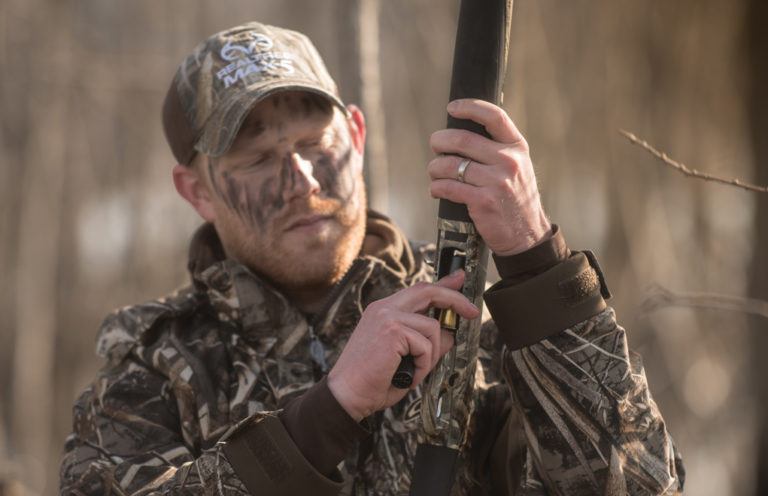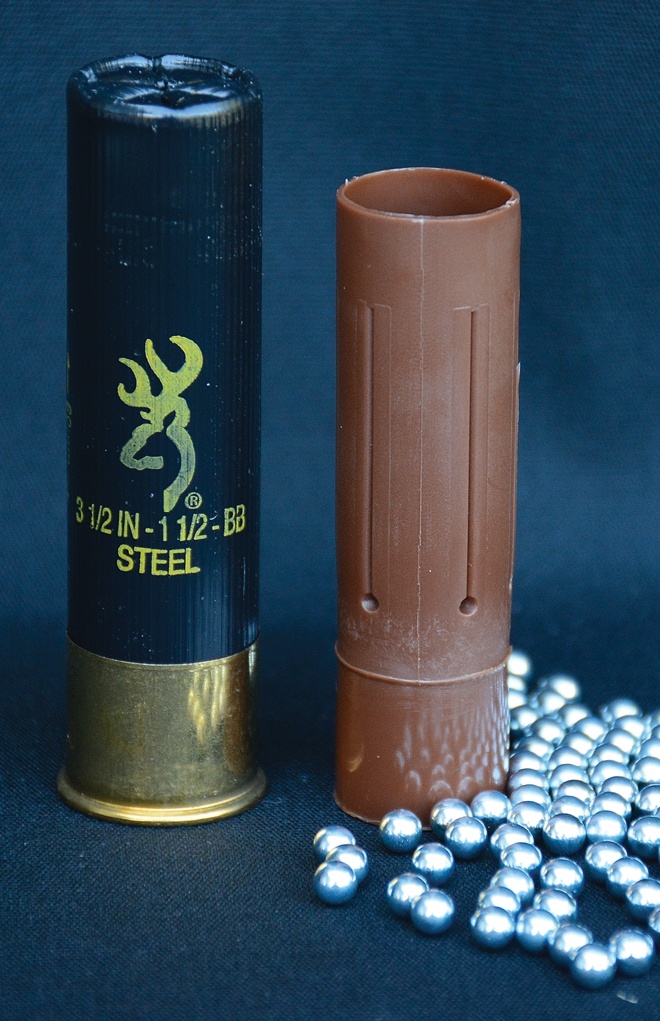
The technology going into steel shot designed for waterfowl has come a long way since it was first mandated in the late ‘80s.
How Modern Steel Shot Has Improved:
- Shells are loaded for higher velocities.
- Playload deliver more energy.
- Wad designs channel shot better.
- More consistent downrange patterns.
- Pellets are consistently round.
- Annealing improvements maintain steels toughness.
If inanimate objects could suffer hurt feelings, steel shot might get pouty. After all, it’s endured many slights and insults in the past 30 years.

Waterfowlers maligned steel shot — actually iron and carbon in composition — when it was mandated as a nontoxic shot alternative for waterfowl hunting in the United States during the late 1980s and early 1990s. Hunters maintained that steel was far inferior to traditional lead loads, and often reported that birds flew away or barely reacted when struck with steel pellets.
Then, as tungsten- or bismuth-based nontoxic alternatives arose, many hunters abandoned steel and opened their wallets for the latest, greatest materials, many of which performed similarly or better than lead, albeit at higher costs.
But nowadays, the pendulum has swung back in favor of steel, and most shooters accept and even celebrate modern steel loads. The reason is simple: Modern steel shotshells provide lethal performance on ducks and geese. In fact, they work so well that older generations of hunters have all but forgotten what it was like to use lead, and younger waterfowlers have only experienced positive results with the only nontoxic shot they’ve used.
Steel’s Coming Of Age
The new love affair with steel is easy to understand when you consider the modern nontoxic shot scene.
“I think there are a couple of reasons for the popularity and adoption of steel as the go-to for waterfowlers,” said Ben Frank, product manager for Winchester Ammunition, which makes Super X Xpert Steel, Drylok Super Steel and Blind Side shells under the Winchester name, and BXD shotshells under the Browning brand. “One reason is cost. There is no doubt that the heavier-than-lead options work great on birds. But as prices of materials like tungsten rose, so did the cost per box.
“Most folks can’t justify $4 per trigger pull,” added Frank. “The other reason that steel is here to stay is that manufacturers have made great strides in the performance of their steel shot loads. Wads, shot, powder and primers have all seen design advancements that have helped contribute to more lethality than the steel shot of yesteryear.”

Dan Compton, product line manager for shotshells with Federal Premium Ammunition, which manufactures Black Cloud and Speed Shok steel shells, agreed. He said early steel offerings attempted to mimic similar lead shotshells in muzzle velocity. For example, a company might have produced a No. 4 steel load that fired pellets at about 1,300 feet per second, which was roughly the same muzzle velocity produced by a No. 4 lead shotshell with a similar payload. That steel load was far less effective, of course, because steel is about 70 percent as dense as lead, so it loses speed and downrange energy far faster.
But as manufacturers gained experience and technology improved, shotshell makers began loading faster steel loads, which gave pellets increased downrange energy and boosted lethality. Nowadays, Compton said, many companies produce 1 3/8-ounce loads with muzzle velocities of at least 1,400 fps. Many 1¼-ounce loads run about 1,450 fps, and lighter offerings can achieve speeds of 1,550 fps or faster.
“Ultimately, you have to deliver pellets to the bird with enough energy to get to the vitals,” Frank said. “Safely and consistently achieving higher velocity is key to generating effective downrange energy. Getting those pellets there in an evenly distributed pattern is almost equally as important.”
That’s where improved wad design comes in. Compton said shot gets pressured in all directions when fired from a cartridge — from behind by gases produced by powder deflagration, in front by friction from air, and from the sides by the shotgun barrel. Therefore, pellets will fly in all directions unless controlled by an efficient wad. Improved modern wads, such as Federal’s Flitecontrol Flex, control shot better, reduce muzzle pressure and channel shot in one direction, resulting in better and more consistent downrange patterns.
Also, manufacturers have improved the process of making steel shot itself, Compton said. Modern pellets are consistently round, and the process of annealing shot — heating it and letting it cool slowly to remove internal stress and toughen it — is also better.
For more shotgun posts check out:
- What’s the Deal with TSS Shotgun Shells?
- Does This Mossberg 590 Tactical Shotgun Blow The Rest Away?
- Top Four Remington 870 Tactical Shotgun Options
- Practical Guide To The Tactical Shotgun
- Ammunition: Shotgun Slugs 101
“I think overall tolerances have gotten better in the industry, and the steel shot you can buy today is better than what you could buy 20 to 30 years ago,” Compton said.
Proof In The Field
Technical talk from shotshell makers sounds good, but it doesn’t get to the heart of the matter — specifically, what type of performance waterfowl hunters can expect from modern steel shotshells.
Compton said modern steel loads fired through an appropriate choke — probably no tighter than modified — will deliver consistently lethal performance to about 40 yards, although claims of longer shots are common.
“Ethically, I think we should always stick to shooting out to 40 yards,” Compton added. “Your pattern really starts to open up then.”
Also shell manufacturers have imbued premium shells with special qualities to enhance performance. Black Cloud FS Steel shells, for example, use Flitestopper pellets, which have a cutting edge designed to devastate tissue on impact and create massive wound channels.
Frank said waterfowlers should consider the conditions and circumstances in which they’ll hunt before selecting a steel shotshell and load. For example, Super X Xpert Steel loads provide high-velocity payloads at affordable price points. Drylok shotshells use premium plated steel shot coupled with a wad-and-primer system designed to keep the powder and priming mix dry in harsh conditions. Blind Side uses Hex Steel for better packing density — that is, more pellets in the shell — and more trauma on impact, plus a diamond-cut wad for ideal patterns, a wad-and-primer system for water resistance, and high velocities (1,300 to 1,400 fps) for downrange energy transfer.
“I think waterfowlers should look at how they think their hunt will play out,” Frank said. “For instance, if you’re hunting in a blind with a lot of passing shots, I’d look for something with a lot of velocity that can deliver tight patterns downrange. I might not be as worried about water resistance because I am in the blind not really getting wet. However, if I am going to be standing in water for hours, (with the) shells possibly getting wet, too, water resistance becomes a real factor and decision-making attribute. If I plan on the ducks decoying or I just plan on shooting decoying ducks, I want something that I can swarm them with pellets.
“I’d also like some choke response,” Frank added. “I still want to be able to reach the end of my spread, so I’m going to try to get that swarm with something with as much velocity as I can get. Velocity and total pellet count is often a bit of a trade-off due to safe allowable pressure specifications. With Winchester and Browning products, we attempt to get the velocity as high as we can for a given payload. Finally, I’d say do a little research on the product you are thinking about purchasing and go pattern your gun.”
The Future Of Steel
As technology advances, steel shotshells will likely continue to evolve and might someday provide even greater hunting performance.

“Folks are always innovating and looking for new and better ways to improve the performance of what is on the market today,” Frank said. “I foresee folks continuing to look at new and existing materials in an effort to solve the cost equation. We haven’t hung up our thinking caps just yet, so we will continue to work to improve upon the great products we already offer. A lot of the innovative products you see today came about due to the competition in the industry. I foresee this competition continuing to help benefit today’s waterfowl hunters.”
Compton said new materials — specifically polymers — might hold the key to tomorrow’s shells. Designers might be able to use advanced polymers to produce new hulls or wads that could create tighter patterns and less recoil.
“Plastics are better than they have ever been, and people are smarter with polymers nowadays,” he said.
Whatever happens, today’s hunters can take satisfaction in knowing their steel shotshells provide in-the-field performance that lead-shooting waterfowlers of yesteryear couldn’t have imagined. It might have taken a couple of decades to get there, but for duck and goose hunters, the wait has been worthwhile.
Editor's Note: This article originally appeared in the November 2017 issue of Gun Digest the Magazine.

Next Step: Get your FREE Printable Target Pack
Enhance your shooting precision with our 62 MOA Targets, perfect for rifles and handguns. Crafted in collaboration with Storm Tactical for accuracy and versatility.
Subscribe to the Gun Digest email newsletter and get your downloadable target pack sent straight to your inbox. Stay updated with the latest firearms info in the industry.

![Best Concealed Carry Guns In 2025 [Field Tested] Wilson Combat EDC X9S 1](https://gundigest.com/wp-content/uploads/Wilson-Combat-EDC-X9S-1-324x160.jpg)


![Best 9mm Carbine: Affordable PCCs [Tested] Ruger Carbine Shooting](https://gundigest.com/wp-content/uploads/Ruger-Carbine-Shooting-100x70.jpg)
![Best AR-15: Top Options Available Today [Field Tested] Harrington and Richardson PSA XM177E2 feature](https://gundigest.com/wp-content/uploads/Harrington-and-Richardson-PSA-XM177E2-feature-100x70.jpg)
